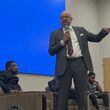Medical experts advised parents to watch for lingering symptoms in Atlanta public schools students exposed to carbon monoxide at Finch Elementary School Monday, but they very likely will see no lingering short term or long term effects on their children.
Dr. Sharon Bergquist, a doctor of internal medicine and primary care at Emory University School of Medicine, said the children would not be released by medical officials if they were still exhibiting symptoms from the exposure.
What are the symptoms of carbon monoxide poisoning?
“The symptoms are kind of flu like from mild exposure – headaches, nausea, dizziness,” said Bergquist, who recommended that the parents be attentive for those symptoms when the students get home, but she expressed no cause for alarm.
What is carbon monoxide?
Carbon monoxide is an odorless, colorless gas that can cause sudden illness and death by blocking oxygen from getting into the body. In high enough concentrations victims can die within two to three minutes, said Bergquist. But the levels of carbon monoxide and length of exposure likely were not enough to act that fast or fatally, said Bergquist.
How much carbon dioxide was found at Finch Elementary? What is a safe level?
According to the Atlanta Fire Department the levels of carbon monoxide detected near the school’s furnace were 1,700 parts per million. The federal Occupational Safety and Health Administration said the allowable level of carbon dioxide is 50 parts per million over an eight hour period.
Bergquist said even though the level at the school was extremely high, it was well below the levels of concentration that can kill quickly. “To be unconscious and die in two to three minutes, you’d have to have twelve thousand to thirteen thousand parts per million,” she said.
Will students have lingering problems?
Bergquist said it’s unlikely that the students will have permanent injury from the exposure. “The milder the symptoms are up front, that bodes better for no long-term effect,” she said.
How common is carbon monoxide poisoning?
According to the CDC each year, more than 400 Americans die from unintentional carbon monoxide poisoning, more than 20,000 visit the emergency room and more than 4,000 are hospitalized due to carbon monoxide poisoning. Fatality is highest among Americans 65 and older.
What should you do if you expect someone has been exposed?
The CDC said treatment for exposure to carbon monoxide begins with removing the person from the exposure and getting them fresh air. In more severe exposures the person is given oxygen, or treated, in the worst cases, in a hyperbaric chamber, where they are administered oxygen at a level higher than atmospheric pressure.





